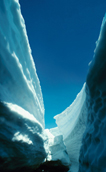Northern Science and Technology
The North. For many Canadians the term evokes polar bears, ice and the northern lights. Add science to that list.
 A combination of factors has moved the Canadian Arctic to the scientific forefront. Scientists predict that the most dramatic climate changes will occur in the North making it a bellwether for broader change. This vast region has enormous untapped oil, natural gas and mineral wealth. And greater self-government in the region, including the creation of the territory of Nunavut, means the need for better understanding of local resources.
A combination of factors has moved the Canadian Arctic to the scientific forefront. Scientists predict that the most dramatic climate changes will occur in the North making it a bellwether for broader change. This vast region has enormous untapped oil, natural gas and mineral wealth. And greater self-government in the region, including the creation of the territory of Nunavut, means the need for better understanding of local resources.
This is why the Government of Canada has northern science and technology as one of its top priorities for integrated science and technology. It's a focus that extends from the role of local traditional knowledge to unprecedented international cooperation.
 The brightest example of this northern scientific flurry is ArcticNet, Canada's most ambitious northern research project ever. This new consortium of Canadian universities and Government of Canada departments and agencies, involves more than 150 scientists. It's primary goal is to document climate change and its impacts in the far north. To do this, biologists, oceanographers, physicists and others, will rely on the newly outfitted CCGS Amundsen, Canada's first dedicated Arctic science icebreaker. The vessel recently successfully completed its first nine month scientific mission, the Canadian Arctic Shelf Exchange Survey.
The brightest example of this northern scientific flurry is ArcticNet, Canada's most ambitious northern research project ever. This new consortium of Canadian universities and Government of Canada departments and agencies, involves more than 150 scientists. It's primary goal is to document climate change and its impacts in the far north. To do this, biologists, oceanographers, physicists and others, will rely on the newly outfitted CCGS Amundsen, Canada's first dedicated Arctic science icebreaker. The vessel recently successfully completed its first nine month scientific mission, the Canadian Arctic Shelf Exchange Survey.
Finding oil and gas in the north depends on knowing where to look. To aid this process, the Targeted Geoscience Initiative of Natural Resources Canada is creating detailed geoscience maps of the North that will guide future exploration. The environmental effects of issues such as contaminants and resource development are at the core of Environment Canada’s long-term Northern Ecosystem Initiative.
Federal science is also playing a key role in understanding and limiting the health impacts of contaminants in the North through the Health Canada-led Northern Contaminants Program. Supporting healthy communities and fish and aquatic mammal populations, Fisheries and Oceans Canada works closely with northern co-management boards to provide the information needed for sustainable harvesting.
To aid all of these projects, Industry Canada, the Canadian Space Agency and Communications Research Centre Canada are collaborating on the development of the National Satellite Initiative. The initiative will provide low-cost, two-way broadband communication for telemedicine, teleteaching and teleworking to the most remote regions in the North.
Collaborative research in the North is even reshaping our understanding of its history, and helping shape its future. The Canadian Museum of Civilization’s Helluland Archaeological Project, involving several government agencies and universities, is documenting contact between Europeans and Inuit in the eastern Arctic 500 years before Columbus. And Canadian scientists are playing a key role in planning landmark Arctic research for International Polar Year in 2007-2008.
Science Issues / Northern Science /
Arctic Mission – The Cyberdocumentary
Relive the extraordinary journey of Sedna IV through the Arctic by following the crew on its search for signs of climage change.
Arctic Research
Learn about Canada's agency for polar research. Access news, publications and more.
ArcticNet
Learn about Canada's most ambitious northern science program and its role in studying the impacts of climate change in the coastal Canadian Arctic.
Canada’s Arctic - Polar Continental Shelf Project
Explore Canada's Arctic, a vast, fascinating landscape consisting of Yukon, the Northwest Territories and Nunavut. Learn about climate, habitat and more.
Canadian Arctic Shelf Exchange Study (CASES)
Discover why monitoring the extent and thickness of Arctic sea ice is an important indicator of climate change, and how a reduction in sea ice could have dramatic environmental, socio-economic and geopolitical consequences.
Canadian Polar Information Network
Learn about Canada's agency for polar research. Access news, publications and more.
Canadian Wildlife Service: Current Activities in the Northwest Territories / Nunavut
Access an overview of Canadian Wildlife Service northern programs and projects. Learn about polar bears, several types of birds and more.
Conserving Wildlife Through the Application of Inuit Traditional and Scientific Knowledge
Access information on a program that helps ensure the protection and wise use of wildlife and wildlife habitat for the long-term benefit of Inuit and the rest of the public of Nunavut and Canada.
International Polar Year Web Site
Discover what Canadian scientists are planning for International Polar Year, which will take place 2007 – 2008.
National Satellite Initiative
Find information on the National Satellite Initiative and discover how your community can participate.
Northern Contaminants Program
Learn about an initiative that works to reduce and, wherever possible, eliminate contaminants in traditionally harvested foods, while providing information to assist informed decision making in food use.
Northern Ecosystem Initiative
Find information about the initiative that works to enhance the health and sustainability of communities and ecosystems across Canada's North.
Sedna IV – A Journey of Discovery Across the Top of the World!
Take an exciting scientific voyage through the Arctic’s fabled North-West Passage through highlights of the adventure and an interactive map.
Strangers, Partners, Neighbours? – The Helluland Archaeology Project
Explore information on the Helluland Archaeology Project, which investigates evidence of relationships between the aboriginal peoples and early Europeans who met in the eastern Arctic in the centuries around A.D. 1000.
Targeted Geoscience Initiative
Find out how this initiative stimulates sustainable economic development across Canada by increasing the level and effectiveness of private sector exploration for energy and mineral resources.






